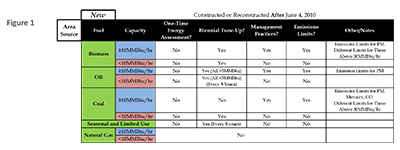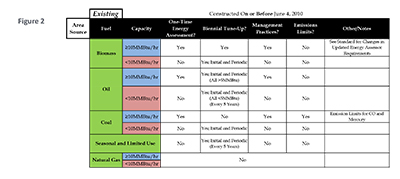A Further Understanding of Boiler MACT for Area and Major Sources
This article is a follow-up to the piece that appeared in the
November issue of Insulation Outlook.
The U.S. national elections appeared to have the
expected, definitive effect on the high-profile Industrial Boiler Maximum
Achievable Control Technology (MACT) regulation. As discussed in November’s
article, the regulation’s two subparts have undergone many changes and much
scrutiny over the past few years. Such controversy delayed the passing of a
definitive standard and placed many industrial, commercial, and institutional
facilities in a considerable amount of confusion. This article will clearly
outline the changes, updates, and final adjustments to the Major and Area
Source Boiler MACT standards.
On December 20, 2012, the U.S.
Environmental Protection Agency (EPA) confirmed the particulars for the Clean
Air Act Boiler MACT standards originally published in March 2011. Throughout
2011 and 2012, the EPA released extensive revisions to the specific National
Emission Standards for Hazardous Air Pollutants (NESHAPs). The standards are
divided between 40 CFR Part 63 Subpart JJJJJJ for affected area sources (sources
emitting fewer than 10 and/or 25 tons per year [tpy] of single HAPs and/or
total HAPS, respectively) and 40 CFR Part 63 Subpart DDDDD for major sources
(sources emitting greater than 10 and/or 25 tpy of single HAPs and/or total
HAPS, respectively), as defined by the respective air permits of the facilities.
All of the final adjustments consider facility concerns and employ new
information. Both subparts still work toward preserving public health by
mitigating toxic air pollution while achieving more flexibility for facilities.
The current Boiler MACT standards
divide facilities’ boilers into subcategories defined by boiler type, capacity,
and fuel type. Based on this information, a source must meet emission limits,
work practice standards (including tune-ups and energy assessments), and
operating limits; and/or demonstrate initial/regular compliance. The facility’s
designation as new or existing also will determine if it is subject to the
varying work practice standards and requirements. Below are some critical facts
regarding the final adjustments to the Boiler MACT standards published on
December 20, 2012, including how they may apply, and what impact they could
have, for your facility.
Area Source Requirements
40 CFR Part 63 Subpart JJJJJJ affects facilities
with the potential to emit fewer than 10 tpy of any single HAP and/or fewer
than 25 tpy of combined HAPs affecting sources with boilers defined as
existing, new, or reconstructed. A majority of the boilers affected by this
standard are in the commercial and institutional sectors. It is anticipated that
the final adjustments to the standard will provide relief to some of the
facilities fearful of meeting regulatory requirements and deadlines.
The health benefits have been
researched and examined methodically by the EPA. Approximate
standard-associated reduced exposure to fine particles has a health benefit
value of $210 million to $520 million by the year 2015. The EPA estimates that
the cost for the final standard, incorporating the cost expected to be incurred
by industry, will be roughly $490 million per year. The final modifications
will not raise the standards’ costs but are intended to ultimately decrease the
burden on smaller facilities with boilers.
Only a small fraction of the
boilers currently operating will be affected by the final adjustments made by
this subpart. Based on the final adjustments, 1.3 million of the 1.5 million
boilers at area sources will not be subject because they run on natural gas. Of
the remaining 183,000 boilers, 182,400 require only regular tune-ups and
possibly a one-time energy assessment. The remaining 1 percent of boilers at
area sources will be obliged to meet the more rigorous emissions limits. These
boilers are chiefly coal burning. Due to how little these sources emit, the EPA
is continuing to require work practice/management practice standards, which
include tune-ups for more than 99 percent of area source boilers covered by the
final standards. Less than 1 percent of area source boilers will need to meet
numerical emission limits.
Some of the changes from the
March 2011 regulation that have been made to the final standards will please
both the agencies and the affected sources. A point-by-point list of the
critical changes to the standards as supplied by the EPA in its Technical Fact
Sheet is available at www.epa.gov/airquality/combustion/docs/20121221_boilers_area_recon_fs.pdf,
summarized below.
Extending by 2 years the initial compliance date for existing area
source boilers subject to the tune-up requirement. Now, existing area source
boilers will have until March 21, 2014 to comply with these standards. If
necessary, they may request an additional year. This provides facilities with
2 additional years to meet the requirements.
Revising the deadline for initial notification for existing area source
boilers to no later than January 20, 2014.
Revising provisions for existing dual-fuel fired units that fuel switch
from gas to coal, biomass, or oil, such that they still would be considered
existing sources.
Providing subcategories for seasonally operated boilers and limited-use
boilers.
Requiring tune-ups every 5 years, instead of every 2 years, for certain
area source boilers: seasonally operated units, limited-use units, small
oil-fired units, and units with oxygen trim systems.
Clarifying that temporary boilers and residential boilers are not part
of the source categories being regulated.
Revising particulate matter (PM) emission limit requirements such that
combustion of oil meeting certain sulfur content requirements by new oil-fired
boilers is considered an alternative method of meeting the PM emission
standard, and such units are not required to meet the PM emission limit.
Reducing the fuel sampling and performance testing requirements such
that after demonstration of initial compliance, under certain circumstances,
further fuel sampling for boilers subject to a mercury emission limit, and
further PM performance testing for boilers subject to a PM emission limit, are
not required.
Providing the option of continuous emissions monitoring to demonstrate
continuous compliance with the carbon monoxide (CO) emission limit.
Defining more clearly the scope of the energy assessment and allowing
for more streamlined assessments, including allowing sources already operating
under certain energy management programs to satisfy the assessment requirement.
Final adjustments to the rule
have taken many factors into consideration, including concerns raised by the
sources. These rules have made the breakdown of subjectivity more complex than
in the March 2011 standard. To best understand what work practice standards
your facility is subject to, review figures 1 and 2, which provide a basic
overview of what needs to be completed to meet the area source standard for
boilers under the final adjustments. Please note several changes from the
tables published previously.
The final rule for area source
boilers is available on the EPA website.
Major Source Requirements
40 CFR Part 63 Subpart DDDDD affects facilities
with the potential to emit greater than or equal to 10 tpy of any single HAP,
and/or greater than or equal to 25 tpy of combined HAPs. This rule includes
boilers and process heaters burning natural gas, fuel oil, coal, biomass (e.g.,
wood), refinery gas, or other gas to produce steam. Unlike Subpart JJJJJJ,
Subpart DDDDD also includes natural gas/propane/clean fuel boilers. These
requirements contain subcategories with very specific requirements.
Similar to the March 2011 rule, of the roughly 14,000 major source
boilers and process heaters in the United States, 88 percent are required to
conduct annual or biennial tune-ups, and 12 percent are required to meet
emission standards if those standards are not already met. The final adjusted
standards will be considered effective upon their publication in the Federal
Register. As with the area source requirements, existing sources will have 3
years from the publication date to comply with the revised standards. If
needed, an additional year can be requested.
For the major source standard, the annual cost, including industry
costs, to implement the standards is estimated to be between $1.4 and $1.6
billion. Overall, though, the costs to comply per boiler are anticipated to
drop from those associated with the March 2011 standards. This is due to
alterations made to emission limits based on research, which include less
strict obligations for the control of particle pollution on biomass units.
Figure 1 from the EPA standard provides extensive summary costs and benefits
associated with the Major Source Boiler MACT reconsideration for 2015.
Here is a point-by-point list
of the critical changes to the initial March 2011 standards as supplied by the
EPA in its Technical Fact Sheet:
- Adding new subcategories for light and heavy industrial liquids to
reflect design differences in the boilers that burn these fuels. - Adding new emission limits for PM that are different for each biomass
fuel subcategory, to better reflect emissions during real-world operating
conditions. - Adding new emission limits for CO based on newly submitted data that
shows CO emissions from boilers vary greatly. The EPA is setting new limits to
more adequately capture that variability. - Allowing alternative total selective metals emission limits to regulate
metallic air toxins instead of using a PM as a surrogate, thus allowing more
flexibility and decreasing compliance costs for units that emit low levels of
HAP metals. - Replacing numeric dioxin emission limits with work practice standards to
reflect a more robust analysis that shows dioxin emissions are below levels
that can be accurately measured. - Increasing flexibility in compliance monitoring by adding alternative
monitoring approaches for demonstrating continuous compliance with the PM
limit. - Adjusting PM and CO emission limits for units located outside the
Continental United States, to reflect new data and better reflect the unique
operating conditions associated with operating these units. - Continuing to allow units burning clean gases to qualify for work
practice standards instead of numeric emission limits. The EPA is removing the
hydrogen sulfide (H2S) fuel specification from the rule because it
does not provide a direct indication of potential HAP from combustion of
gaseous fuel. Instead, mercury content alone is used to determine clean gas.
To best understand what
standards your major source facility may be subject to, review the major source
standard for boilers under the final adjustments. Again, please note several
changes from the tables published previously. There also are many nuanced
variations based on fuel type and limit specifics that are not included on the
table. The one major change to this subpart is that new boilers are no longer
subject to a one-time energy assessment. All existing boilers and process
heaters at a major source facility, however, still must conduct a one-time
energy assessment for compliance. Please review the actual regulation for
specifics (see www.epa.gov/airquality/combustion/docs/20121221_boilers_major.pdf).
There are many intricacies to
these regulations, and the final adjustments-particularly for the major source
standard-are far too detailed to examine here. Further reading is recommended.
Sources
for Further Reading:
- National Emission Standards for
Hazardous Air Pollutants for Major Sources: Industrial, Commercial, and
Institutional Boilers and Process Heaters (www.epa.gov/airquality/combustion/docs/20121221_boilers_major.pdf) - National Emission Standards for
Hazardous Air Pollutants for Area Sources: Industrial, Commercial, and
Institutional Boilers (www.epa.gov/airquality/combustion/docs/20121221_neshap_ici_boilers_fin.pdf) - EPA’s Air Toxics Standards Major and
Area Source Boilers and Certain Incinerators Technical Overview: Adjustments
from March 2011 Final Standards (www.epa.gov/airquality/combustion/docs/20121221_tech_overview_boiler_ciswi_fs.pdf)


